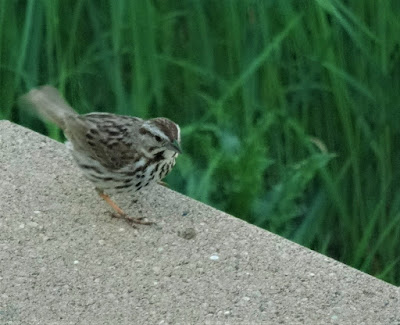6/21/2023
6/17/2023
6/16/2023
killdeer
Killdeer Charadrius vociferus is a shorebird that is part of the plover family. About the size of a American Robin, it has very long legs and striped black and white neck. It usually inhabits grassy areas but eats mostly invertebrates. This one was foraging along the shore for aquatic insect larvae. The scientific name "vociferus" is from Latin; 'vox' meaning "voice" with 'ferre' meaning "to carry". Their call is surely carrying! https://musicofnature.com/mary-holland/killdeer/
6/10/2023
floating log
6/05/2023
prairie smoke gone to seed
We added Prairie Smoke Geum triflorum to the riparian area around the pond last year. They survived the winter, and bloomed mid-May.
Now each flower has transformed into clusters of feathery, wispy plumes that eventually will spread seeds as they wave in the breeze.
6/03/2023
blue flag
Northern Blue Flag Iris versicolor has a deep blue to purple flower. It is also called Harlequin Blueflag.
It grows on lake shores, swamps, pond edges, and wet meadows.
Blue Flag irises occur throughout the USA, in several varieties. Some plants are located on the south shore of the pond, and are blooming now.
5/29/2023
ox-eye daisy - invasive
Ox-eye Daisy Leuceanthemum vulgare is a perennial herbaceous species with a creeping root system.
This daisy is not native to Minnesota, but imported as an pretty ornamental flower.
It turned out to be an aggressive invasive species. Once established, it can spread rapidly by means of roots and seeds, and block sunshine for other native wildflowers.
5/26/2023
song sparrow
Song Sparrow Melospiza melodia live up their binomial nomenclature 'melodia' by singing a delightful song, enthusiatically, and often.
They move along wetland edges like around the pond. I see the males occasionally, but they spend most of the time in dense, low vegetation.
5/22/2023
nest box Tree Swallows
Tree Swallows nest in cavities . . . old woodpecker holes in trees, or nest boxes. They do not go far south in winter; they return to Minnesota before any other swallows. They can eat plant foods, so they can survive before the insects come out. In the nest box near the pond, the Tree Swallow laid one egg each day in the last six days. She started incubating the eggs today. They will hatch in 11 to 20 days.
5/21/2023
5/20/2023
5/17/2023
prairie smoke
5/16/2023
5/15/2023
violets by pond
5/09/2023
pair of blue winged teal
5/03/2023
sandpipers
4/30/2023
yellow loosestrife
 |
| Daffodil (left) besides young Lysimachia leaves |
Lowland Yellow Loosestrife Lysimachia hybdrida, a perennial native plant, is sprouting again near the pond. The stems will to grow to 30-40 inches tall, then flowers will appear in June. Some specialist bees will gather the oils that the flower produces to mix with pollen as food for its offspring.
pasque flowers
4/29/2023
muskrat, greener pastures
4/28/2023
4/27/2023
yellow-rumped warbler
Yellow-rumped Warblers Setophaga coronata arrived here on the pond today on migration to the northern part of Minnesota and Canada, where they will nest and breed young birds. Also called "Myrtle" Warblers. On migration they eat fruits and seeds. Here, they flit along the shoreline hunting insects among the grasses. These individuals came to the feeders to eat thistle and sunflower chips. When more insects appear and the Warblers arrive on the breeding ground up north, they will eat caterpillars and other larvae, small beetles, weevils, ants, scale insects, aphids, grasshoppers, caddisflies, spiders, and gnats.
4/25/2023
northern shovelers in Spring
Northern Shovelers visited the pond today. They eat tiny crustaceans, other aquatic invertebrates, and seeds in and around the pond. To filter food out of the water, they have comb-like projections (called lamellae) along the edge of their bills. Lamellae are slightly pliable. They help many ducks, gooses, and other birds eat by filtering edible items from mud or water.
4/20/2023
hooded mergansers in Spring
We have three types of Mergansers in North America. The smallest of the group is the Hooded Merganser. These are diving ducks; their long bills are slender with serrated edges, formed like teeth for grasping and holding their prey. They dive in lakes or ponds, staying under water up to two minutes, while hunting for small fish, crustaceans, amphibians, or roots.




























